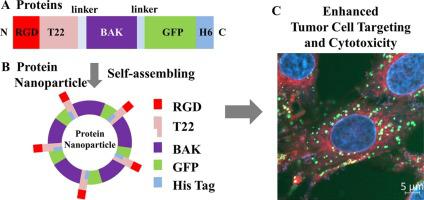当前位置:
X-MOL 学术
›
Biomed. Pharmacother.
›
论文详情
Our official English website, www.x-mol.net, welcomes your
feedback! (Note: you will need to create a separate account there.)
Design of integrin αvβ3 targeting self-assembled protein nanoparticles with RGD peptide.
Biomedicine & Pharmacotherapy ( IF 6.9 ) Pub Date : 2020-05-21 , DOI: 10.1016/j.biopha.2020.110236 Xiangfeng Lv 1 , Chun Zhang 1 , Qingyun Shuaizhen 1 , Rong Yu 1 , Yongxiang Zheng 2
Biomedicine & Pharmacotherapy ( IF 6.9 ) Pub Date : 2020-05-21 , DOI: 10.1016/j.biopha.2020.110236 Xiangfeng Lv 1 , Chun Zhang 1 , Qingyun Shuaizhen 1 , Rong Yu 1 , Yongxiang Zheng 2
Affiliation

|
Integrin αvβ3 was reported as positive regulators of tumorigenesis and highly expressed in cancer stem cells and kinds of cancers, thus, it is an appealing target for cancer treatment. Nanomedicine with targeting delivery ability has developed rapidly and shown its great therapeutic potential in cancer therapy. Proteins are ideal material for nanomedicine regarding to their excellent biocompatibility, and protein-only self-assembled nanoparticles technology provides a robust method to produce protein nanoparticles. Pro-apoptotic proteins or peptides, such as BAK, have attracted increasing attention in the inhibition of tumor growth. However, the self-assembled nanoparticles of BAK targeting to integrin αvβ3 over-expressed tumor cells need to be investigated. In this study, we designed recombinant proteins with BH3 BAK as active domain and RGD peptides as targeting ligands to self-assemble into protein nanoparticles (named as PN2-1 et al.), then experimentally evaluated the nanoparticle size, fluorescence feature, stability, targeting ability and cytotoxicity to tumor cells in vitro. The results showed that the protein nanoparticles containing RGD peptides had a uniform particle size with an diameter of approximately 23 nm. PN2-1 had notable inhibition to cell proliferation of C6 cells, C26 cells and MCF-7 cells, with a lower IC50 than the nanoparticles which only had BAK motif without RGD peptide. PN2-1 had higher cellular uptake into C6 cells than MCF-7 cells. Our results demonstrate that the RGD peptide could enhance the cytotoxicity of BAK nanoparticles to tumor cells and increase their tumor targeting ability. This study provides an insight into the design and development of integrin αvβ3 targeting protein nanoparticle for cancer treatment.
中文翻译:

具有RGD肽靶向自组装蛋白纳米颗粒的整合素αvβ3的设计。
据报道,整联蛋白αvβ3是肿瘤发生的正调节剂,并且在癌症干细胞和各种癌症中高表达,因此,它是治疗癌症的诱人靶标。具有靶向递送能力的纳米药物发展迅速,并显示出其在癌症治疗中的巨大治疗潜力。蛋白质具有出色的生物相容性,因此是用于纳米医学的理想材料,仅蛋白质的自组装纳米颗粒技术为生产蛋白质纳米颗粒提供了可靠的方法。促凋亡蛋白或肽,例如BAK,在抑制肿瘤生长方面引起了越来越多的关注。然而,需要研究靶向整合素αvβ3过度表达的BAK的自组装纳米颗粒。在这个研究中,我们设计了以BH3 BAK为活性域和RGD肽为靶向配体的重组蛋白,以自组装成蛋白纳米颗粒(命名为PN2-1等),然后通过实验评估了纳米颗粒的大小,荧光特性,稳定性,靶向能力和细胞毒性体外培养肿瘤细胞。结果表明,含有RGD肽的蛋白质纳米颗粒具有均匀的粒径,其直径约为23nm。PN2-1对C6细胞,C26细胞和MCF-7细胞的细胞增殖具有显着的抑制作用,其IC50低于仅具有BAK基序而没有RGD肽的纳米粒子。PN2-1具有比MCF-7细胞更高的C6细胞摄取率。我们的结果表明,RGD肽可以增强BAK纳米颗粒对肿瘤细胞的细胞毒性,并提高其肿瘤靶向能力。
更新日期:2020-05-21
中文翻译:

具有RGD肽靶向自组装蛋白纳米颗粒的整合素αvβ3的设计。
据报道,整联蛋白αvβ3是肿瘤发生的正调节剂,并且在癌症干细胞和各种癌症中高表达,因此,它是治疗癌症的诱人靶标。具有靶向递送能力的纳米药物发展迅速,并显示出其在癌症治疗中的巨大治疗潜力。蛋白质具有出色的生物相容性,因此是用于纳米医学的理想材料,仅蛋白质的自组装纳米颗粒技术为生产蛋白质纳米颗粒提供了可靠的方法。促凋亡蛋白或肽,例如BAK,在抑制肿瘤生长方面引起了越来越多的关注。然而,需要研究靶向整合素αvβ3过度表达的BAK的自组装纳米颗粒。在这个研究中,我们设计了以BH3 BAK为活性域和RGD肽为靶向配体的重组蛋白,以自组装成蛋白纳米颗粒(命名为PN2-1等),然后通过实验评估了纳米颗粒的大小,荧光特性,稳定性,靶向能力和细胞毒性体外培养肿瘤细胞。结果表明,含有RGD肽的蛋白质纳米颗粒具有均匀的粒径,其直径约为23nm。PN2-1对C6细胞,C26细胞和MCF-7细胞的细胞增殖具有显着的抑制作用,其IC50低于仅具有BAK基序而没有RGD肽的纳米粒子。PN2-1具有比MCF-7细胞更高的C6细胞摄取率。我们的结果表明,RGD肽可以增强BAK纳米颗粒对肿瘤细胞的细胞毒性,并提高其肿瘤靶向能力。





























 京公网安备 11010802027423号
京公网安备 11010802027423号